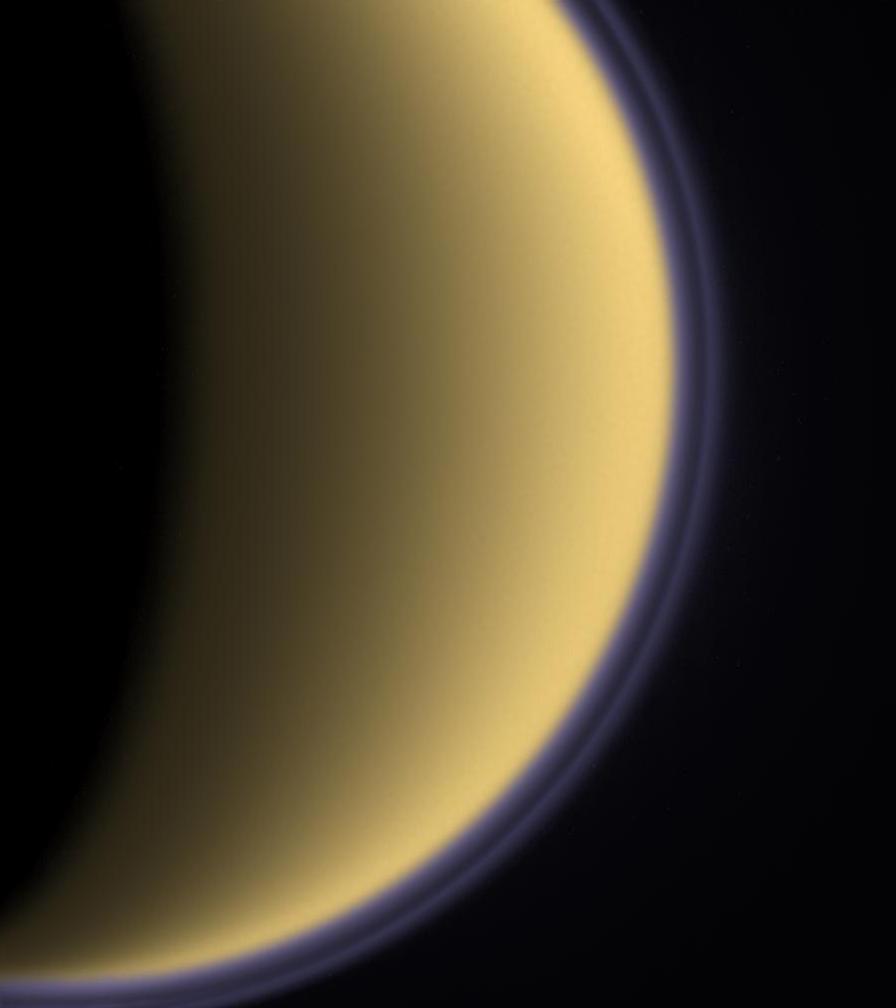NASA | JPL-Caltech | Cassini Solstice Mission | GSFC | 2012 Apr 24
Saturn's giant moon Titan hides behind a thick, smoggy atmosphere that's well known to scientists as one of the most complex chemical environments in the solar system. It's a productive "factory" cranking out hydrocarbons that rain down on Titan's icy surface and cloak it in soot. With a brutally cold surface temperature of around minus 270 degrees Fahrenheit (minus 170 degrees Celsius), the hydrocarbons form lakes of liquid methane and ethane.
However, the most important raw ingredient in Titan's chemical factory is methane gas. Methane is a molecule made up of one carbon atom joined to four hydrogen atoms. It should not last long because it's being continuously destroyed by sunlight and converted to more complex molecules and particles. New research from NASA-funded scientists attempts to estimate how long this factory has been operating. The results are presented in two papers appearing in the April 20 issue of the Astrophysical Journal.
These papers used data collected by two instruments onboard NASA's Cassini spacecraft in orbit around Saturn and one instrument on the European Space Agency's Huygens probe that landed on Titan's surface in January 2005. All three instruments were built at NASA's Goddard Space Flight Center in Greenbelt, Md. A paper led by Conor Nixon of the University of Maryland, College Park uses infrared signatures (spectra) of methane from Cassini's composite infrared spectrometer to estimate how much "heavy" methane containing rare isotopes is present in Titan's atmosphere.
Isotopes are versions of an element with different weights, or masses. For example, carbon 13 is a heavier (and rare) version of the most common type of carbon, called carbon 12. Occasionally, a carbon-13 atom replaces a carbon-12 atom in a methane molecule. Because methane made with carbon 12 is slightly lighter, the chemical reactions that convert it to more complex hydrocarbons happen a bit faster. This means carbon-12 methane gets used up at a slightly faster rate than heavy carbon-13 methane, so the concentration of heavy methane in Titan's atmosphere increases slowly.
By modeling how the concentration of heavy methane changes over time, the scientists predicted how long Titan's chemical factory has been running.
"Under our baseline model assumptions, the methane age is capped at 1.6 billion years, or about a third the age of Titan itself," said Nixon, who is stationed at Goddard. "However, if methane is also allowed to escape from the top of the atmosphere, as some previous work has suggested, the age must be much shorter -- perhaps only 10 million years -- to be compatible with observations."
Both scenarios assume that methane entered the atmosphere in one burst of outgassing, probably from the restructuring of Titan's interior as heavier materials sank towards the center and lighter ones rose toward the surface.
"However, if the methane has been continuously replenished from a source, then its isotopes would always appear 'fresh' and we can't restrict the age in our model," said Nixon. Possible sources include methane clathrates, basically a methane molecule inside a "cage" or lattice of ice molecules. Methane clathrates are found in the frigid depths of Earth's oceans, and some scientists think there could be an ocean of liquid water mixed with ammonia (acting as antifreeze) beneath Titan's water-ice crust. If this is so, methane might be released from its clathrate cages during the eruptions of proposed 'cryovolcanoes' of water-ammonia slurry, or more simply could slowly seep out through fractures in the crust.
The second Titan paper by Kathleen Mandt of the Southwest Research Institute, San Antonio, and colleagues also models the time-evolution of methane. In this work, the concentration of the heavy methane is determined from measurements by Cassini's ion and neutral mass spectrometer, which counts molecules in the atmosphere of different masses (weights). Measurements made by the Huygens gas chromatograph mass spectrometer, which also counts molecules of different masses, were used to constrain the impact of escape on the heavy methane in the atmosphere.
"We compute that, even if methane has been replenished from the interior over time to match or exceed the amounts fed into the atmospheric chemical factory, the process must have been running for a maximum of one billion years," said Mandt. "If the process had started any earlier, we would see a build-up of methane in the lakes on the surface and in the atmosphere beyond what is observed today."
Together these papers add important new perspectives and constraints on the history of Titan's methane atmosphere, confirming that it must have formed long after Titan itself. Previous work considering the evolution of Titan's interior predicted the last major methane eruption occurred 350 million to 1.35 billion years ago, while crater counting has put the age of the current surface at 200 million to one billion years. (Crater counting works on the principle that an older surface has more craters, just as the longer you're in a paintball game, the more hits you'll get.)
The present work for the first time estimates the methane age from the atmosphere itself, at less than one billion years, considering both papers.
Scientists Assess Age of Titan's Organic Atmosphere
Southwest Research Institute (SwRI) | 2012 Apr 24
Shrouded in a thick, complex, organic haze, Saturn's giant moon Titan is proving to be one of the most scientifically interesting destinations in the solar system. Titan's atmosphere, which is mostly molecular nitrogen with a touch of methane, produces chemically complex hydrocarbons that rain down on Titan's icy surface, forming dunes of organic material. The greenhouse effect provided by methane keeps the surface temperature around minus 270 degrees Fahrenheit, allowing lakes of liquid methane and ethane to form on the surface.
- [i]Using Cassini spacecraft data, Southwest Research Institute scientists are studying the atmosphere of Titan, Saturn’s largest moon and the only known extraterrestrial body with a hydrologic cycle similar to the Earth’s, where methane rains down on Titan surface much like water falls to the Earth. This artist’s rendition shows a rainstorm of methane falling on the mountains surrounding Titan’s Hotei Arcus (by Michael Carroll, based upon radar mapping data from Cassini). (Credit: NASA/JPL)[/i]
- [i]This false color composite of Titan, taken during a 2005 Cassini spacecraft flyby, shows both surface features (green) as well as areas high in Titan’s stratosphere where atmospheric methane is absorbing sunlight (red). Southwest Research Institute scientists authored a paper in the Astrophysical Journal, using data from Cassini to predict the age of Titan’s current nitrogen-methane atmosphere. (Credit: NASA/JPL/SSI)[/i]
The history of methane in Titan's atmosphere is the subject of two papers published in the April 20 issue of the Astrophysical Journal. NASA-funded scientists are isolating and measuring the isotopic composition of the methane gas, creating models to better understand how long Titan's atmosphere has been cranking out organic materials.
"Methane's role on Titan is much like the role of water in the Earth's climate," explains Dr. Kathleen Mandt, the lead author of one of the papers and a scientist at Southwest Research Institute in San Antonio, Texas. "First, methane and water are the dominant greenhouse gases on Titan and Earth, respectively, increasing surface temperatures. Second, methane rain falls on the surface of Titan much like water does on Earth. Because Titan is the only other known body with a hydrologic cycle similar to our own, understanding how long methane has been present in Titan's atmosphere is important for making sense of this unique environment that is so different, yet so much like, our own world."
Together, the research presented in the papers estimates the age of Titan's current nitrogen-methane atmosphere at less than one billion years, confirming that the atmosphere in its current state formed long after Titan itself. Methane, comprised of one carbon atom joined to four hydrogen atoms, breaks down relatively quickly in the atmosphere as ultraviolet sunlight converts it into more complex molecules and particles. By modeling the concentration of isotopically heavy methane over time, scientists can predict the age of Titan's atmosphere. Isotopes are versions of an element with different weights, or masses. For example, carbon 13 is rare, heavier version of the most common type of carbon, carbon 12. Occasionally, a carbon-13 atom replaces a carbon-12 atom in a methane molecule. Because methane made with carbon 12 is slightly lighter, the chemical reactions that convert it to more complex hydrocarbons happen a bit faster. This means carbon-12 methane gets used up at a slightly faster rate than heavy carbon-13 methane, so the relative concentration of heavy methane in Titan's atmosphere increases slowly.
Mandt and several SwRI colleagues modeled the time-evolution of methane using data from NASA's Cassini spacecraft, which has been orbiting Saturn since 2004, and the European Space Agency's Huygens probe that landed on Titan's surface in January 2005. The SwRI team measured the relative concentration of the heavy methane using Cassini's Ion and Neutral Mass Spectrometer and compared the results to those measured on Titan's surface by the Huygens Gas Chromatograph Mass Spectrometer, which both identify and count molecules based on their mass. Comparing these two sets of measurements allowed the scientists to understand the impact of escape on the amount of heavy methane present in the atmosphere.
"We compute that even if methane has been replenished from the interior over time to match or exceed the amounts fed into the atmospheric chemical factory, the process must have been running for a maximum of one billion years," said Mandt. "If the process had started any earlier, we would see a build-up of methane in the lakes on the surface and in the atmosphere beyond what is observed today."
The second paper, led by Dr. Conor Nixon of the University of Maryland, College Park, discusses the use of infrared signatures (spectra) of methane from Cassini's Composite Infrared Spectrometer to estimate the levels of "heavy" methane containing rare isotopes present in Titan's atmosphere. Researchers also determined the role of chemical reactions in influencing the isotopic composition of methane in Titan's atmosphere and illustrated the importance of chemistry to understanding the lifetime of methane.
"It is great to experience the scientific maturity of the Cassini-Huygens program, where information from many different investigations is being combined to answer fundamental outstanding questions," said SwRI Institute Scientist Dr. Hunter Waite, the principal investigator of Cassini's Ion and Neutral Mass Spectrometer.
Isotopic Ratios in Titan's Methane: Measurements and Modeling - C. A. Nixon et al
- Astrophysical Journal 749(2) 159 (2012 Apr 20) DOI: 10.1088/0004-637X/749/2/159
- Astrophysical Journal 749(2) 160 (2012 Apr 20) DOI: 10.1088/0004-637X/749/2/160



